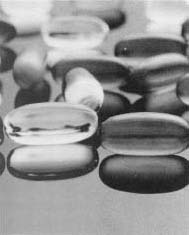Antihistamine
Antihistamines are drugs used to relieve the symptoms of allergies caused by histamine, an organic (natural, basic) compound made from the amino acid histidine. Histamine is released from certain cells when the body is irritated by outside substances, such as pollen, or if the body thinks that a certain food is an enemy rather than a friend. The body then tries to expel the perceived invader by swelling tissues and creating the typical symptoms of an allergic reaction, such as sneezing, hives (skin rashes), or in the case of food allergies, stomach upset and diarrhea as well. Histamine was first recognized and suggested as the cause of allergic reactions by Henry Dale (1875-1968) and Patrick Playfair Laidlaw (1881-1940) in 1910. By 1932 histamines were confirmed as causative agents in allergic response.
Bovet's Research
Researchers then sought to find substances that could counteract the effects of histamines. Swiss-born Italian pharmacologist Daniel Bovet (1907-; winner of the 1957 Nobel Prize for medicine) of the Pasteur Institute in Paris, France, focused on this problem in 1936. Since histamine is extremely toxic except when introduced to the body by absorption through the intestine, Bovet reasoned that histamine must normally exist in the body in combination with a neutralizing agent (a substance that renders other matierial inactive or ineffective). Only "free" histamine would produce allergic symptoms, so an antagonist (opposite) to this free histamine had to be found. Bovet could not discover a natural antagonist to histamine, so he looked for substances that were similar in chemical structure to it, to see if they had antagonists that might be modified to work against histamine. Because the two hormones adrenaline and acetylcholine are structurally similar to histamine, Bovet investigated two groups of substances called sympatholitics and parasympatholitics, which block the effects of adrenaline and acetylcholine. This approach proved fruitful, and in 1937 Bovet and his research student Anne-Marie Staub succeeded in synthesizing the first antihistamine. This first attempt was too toxic to use in humans, however, so from 1937 to 1941 Bovet conducted thousands of experiments to produce a usable antihistamine. He succeeded with pyrilamine, which was introduced to the public in 1944.
Bovet's work laid the foundation for the safe, effective synthesis of antihistamines. In further developments, Bernard N. Halpern, a French research biologist and physician, described the use of phenbenzamine in 1942. And in 1943 a young lecturer at the University of Cincinnati named George Rieveschl developed diphenhydramine, better known as Benadryl.
Beyond Allergy Relief
Once developed, antihistamines became wildly popular. They were promoted by rival drug companies for relief of symptoms of the common cold as well as allergies. Debate still continues in the scientific community on the actual effectiveness of antihistamines against cold virus symptoms. They seem to provide only minor relief on their own, except for clemastine (in found in Tavist-1 and Tavist-D), which may provide modest relief of cold symptoms. Another function for antihistamines was discovered by accident in 1947 when an allergy patient took an antihistamine called Dramamine and unexpectedly found that for the first time in years, she did not suffer from motion sickness when she rode a streetcar.

[See also Adrenaline ; Hormone ]